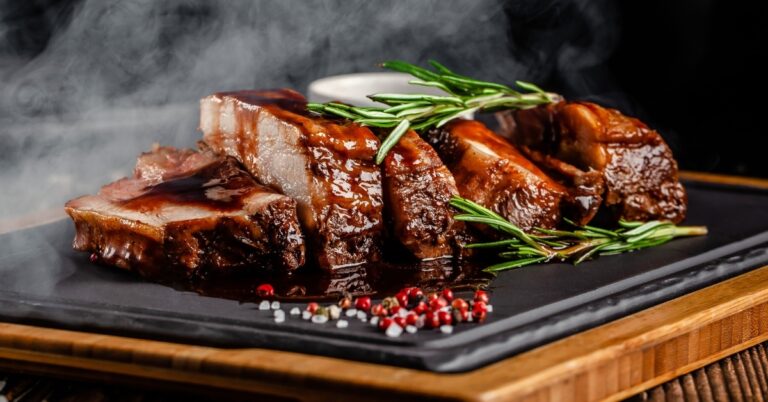When it comes to smoked meat, understanding its shelf life is to ensure food safety and quality. Factors such as storage conditions, type of meat, and the smoking process can all impact how long smoked meat last.
By knowing the proper storage methods and signs of spoilage, you can enjoy your smoked meat deliciously, and safely.
What Is Smoked Meat?
Smoked meat results from a process that involves flavoring, cooking, and preserving meat through exposure to smoke generated by smoldering or burning material, typically wood.
This technique infuses the meat with a distinct smoky taste and contributes to its preservation by impeding bacterial growth.
A variety of meats, including beef, pork, poultry, and fish, can undergo the smoking process, yielding an assortment of flavorful smoked meat products.
Factors Affecting The Shelf Life Of Smoked Meat
The shelf life of smoked meat is influenced by several factors, including the type of meat, the curing process, the smoking method, and the storage conditions. The type of meat used, such as beef, pork, or poultry, can impact how long the smoked meat will last.
Additionally, the curing process, including the use of salt and other preservatives, can affect the shelf life. The smoking method, temperature, and duration also play a role in determining the longevity of smoked meat.
Finally, proper storage conditions, such as temperature and humidity, are crucial factors in extending the shelf life of smoked meat.
Why Do People Smoke Their Meat?
People smoke meat for several reasons, including enhancing flavor, preserving, and creating a unique culinary experience. The smoking process imparts a rich, smoky flavor to the meat, adding depth and complexity to its taste. Additionally, smoking can help preserve the meat by inhibiting bacterial growth and extending its shelf life.
Furthermore, the tradition of smoking meat has cultural and historical significance in many regions and is often associated with communal gatherings and traditional cooking methods.
Smoking meat is a time-honored practice that yields delicious, flavorful results and provides a connection to culinary heritage.
How Can You Tell If Your Meat Has Been Properly Smoked?
To assess the quality of smoked meat, observe the exterior for a well-developed, mahogany-colored surface, indicating thorough smoke penetration. Furthermore, a discernible yet balanced smoky aroma should be evident without overpowering the senses.
Upon slicing, the meat should display a consistent smoky coloration throughout, accompanied by a moist and tender texture. A well-smoked meat should also offer a harmonious flavor profile, where the smokiness enhances the natural meat flavor without overshadowing it.
Indications of spoiled smoked meat encompass an off-putting or rancid odor, an altered texture characterized by a slimy or sticky consistency, and a deviation in coloration, notably presenting as a greenish or grayish hue.
Furthermore, the presence of visible mold, if it exhibits a fuzzy or extensive manifestation, serves as a definitive signal of meat spoilage, necessitating its disposal to mitigate the potential risk of foodborne illness.
Storing Smoked Meat Properly
Properly storing smoked meat is essential for maintaining its freshness and quality. It should be wrapped tightly in plastic wrap or aluminum foil to prevent exposure to air. After wrapping, place the smoked meat in an airtight container or resealable plastic bag to protect it from air and moisture.
Store the meat in the refrigerator below 40°F (4°C) to slow down the growth of bacteria. For longer-term storage, smoked meat can be frozen, but it’s important to use airtight freezer-safe packaging to prevent freezer burn. Always label the stored meat with the date to keep track of its freshness.
Safe Consumption Of Smoked Meat
When consuming smoked meat safely, be mindful of proper storage and handling practices. Here are some tips for safe consumption of smoked meat:
1. Proper Storage: Store smoked meat in airtight containers or vacuum-sealed bags to maintain freshness and prevent exposure to air and moisture.
2. Refrigeration: Keep smoked meat refrigerated at a temperature below 40°F (4°C) to slow down the growth of bacteria and extend its shelf life.
3. Freezing: For longer-term storage, freeze smoked meat in airtight freezer-safe packaging to prevent freezer burn and maintain quality.
4. Labeling: Always label stored smoked meat with the date to keep track of its freshness and ensure timely consumption.
5. Inspection: Before consumption, inspect the smoked meat for any signs of spoilage, such as off-putting odor, altered texture, or unusual coloration. Discard any smoked meat that shows signs of spoilage.
By following these guidelines, you can enjoy smoked meat safely and minimize the risk of foodborne illness.
Signs Of Spoiled Smoked Meat
Smoking meat can offer potential health benefits, including the preservation of meat through the reduction of moisture content, which inhibits bacterial growth and spoilage.
Additionally, the smoking process can contribute to the formation of compounds with antioxidant and antimicrobial properties, potentially enhancing the shelf life of the meat. The signs of spoiled smoked meat are usually
- An off putting or offensive odour
- Discoloration
- Presence of visible mold
- Check expiration date on packaged meat
- Cross- contamination
Read Also:
Conclusion
Understanding the factors that influence the shelf life of smoked meat is essential for maintaining food safety and quality. Proper storage, including refrigeration or freezing, can significantly extend the longevity of smoked meat.
Recognizing the signs of spoiled smoked meat is crucial in preventing foodborne illness. While smoked meat offers unique flavors and textures, it’s important to consume it within recommended time frames to ensure optimal freshness.



